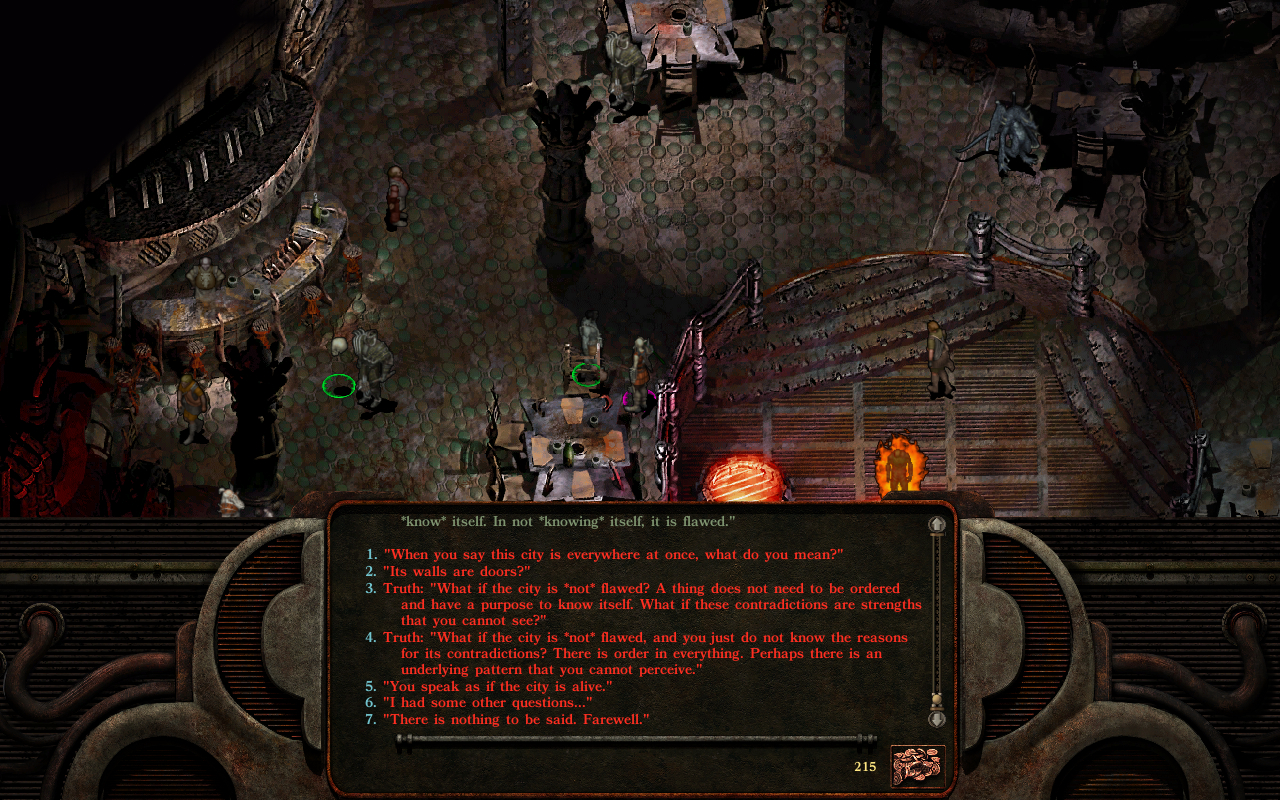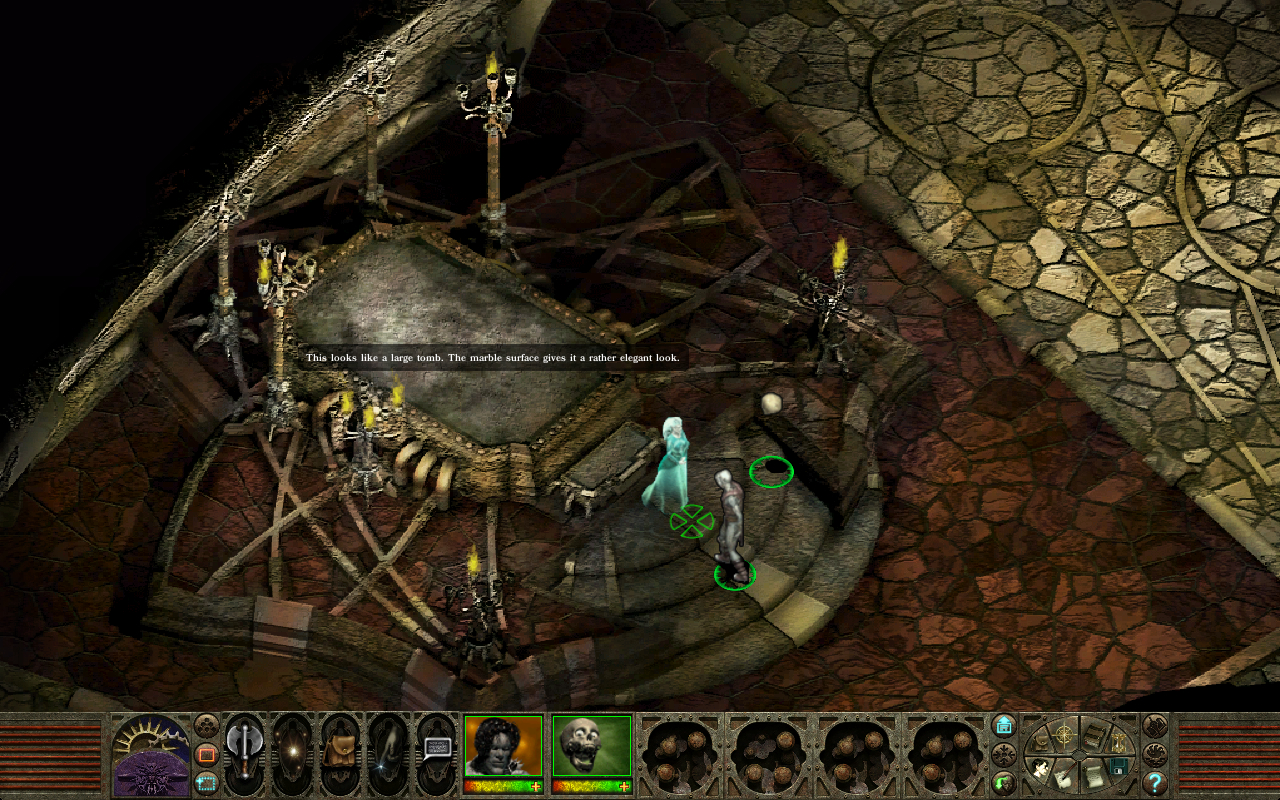Search
[{{{type}}}] {{{reason}}}
{{/data.error.root_cause}}{{{_source.title}}} {{#_source.showPrice}} {{{_source.displayPrice}}} {{/_source.showPrice}}
{{#_source.showLink}} {{/_source.showLink}} {{#_source.showDate}}{{{_source.displayDate}}}
{{/_source.showDate}}{{{_source.description}}}
{{#_source.additionalInfo}}{{#_source.additionalFields}} {{#title}} {{{label}}}: {{{title}}} {{/title}} {{/_source.additionalFields}}
{{/_source.additionalInfo}}- Details
- Category: Computer
- By J. Todd Cumming
- Hits: 7259
Planescape: Torment: Enhanced Edition (Mac)

Planescape: Torment: Enhanced Edition
Developed by: Beamdog
Published by: Beamdog
Released: April 11, 2017
Available on: Android, iOS, Linux, macOS, Windows
Genre: Role-playing game
ESRB rating: T for Teen: blood, suggestive themes and violence
Number of players: 1
Price: $19.99 (Linux, macOS, Windows); $9.99 (Android, iOS)
Over the years, many game review sites have compiled lists of the best computer role-playing games ever created. Although these lists vary widely, the original Planescape: Torment consistently made it into the top ten, often as the number one spot. When Beamdog started converting the Black Isle games to modern systems, many people eagerly awaited the time when Planescape would also receive the “Enhanced Edition” treatment. Now, the wait is over.
Planescape: Torment is based on the 2nd Edition Dungeons and Dragons rules, and indeed came about towards the end of that edition's run. That is about all Planescape has in common with those rules, though – from the start, players face a lot of differences from the tabletop system they may be familiar with. At character creation, the player can allocate points to the familiar attributes of strength, dexterity, constitution, intelligence, wisdom and charisma. But that is all they are permitted to do – they can't choose their character portrait, they can't pick an alignment, gender or class. They can't even give this character a name! Their only choice is to play a hulking, ugly brute with scarred, grey skin. In terms of character creation, this D&D game is the worst.
That sense of disappointment may be short-lived. Your character wakes up in a morgue with no memory of his past, including his name. His only companion is a sarcastic floating skull named Morte. Right away, the storyline grabs you and doesn't let up. You'll be drawn into this bizarre universe of steampunk and clockwork, explore the massive City of Doors, meet new and unusual beings from multiple universes, and try to solve the many mysteries in your character's life. Who are you? Where did you come from? And most importantly, why can't you die?
This game was groundbreaking in 1999 because of the way character development was handled. The people and environment changed as the player made decisions. If you acted in an evil fashion, the Nameless One's alignment would shift accordingly, along with the attitudes of those around him. Likewise with good actions, which led to a good alignment and different companionships. A central morality system had only previously been handled by another RPG classic, Ultima IV, but has been duplicated and improved on many times because of the influence of these games. Although combat is a factor of the game, it takes a backseat to the conversation and role-playing portions. Your interaction with the NPCs is what drives the gameplay, and most of the experience points you gain will be through dialogue and retrieving the lost memories of the Nameless One.

Strong Points: Long gameplay; powerful storyline; game environment strongly affected by player's choices; excellent voice acting and music
Weak Points: Cumbersome combat system; dated graphics
Moral Warnings: Blood and gore; language; demons and hellish landscapes; innuendo and revealing outfits; strong undead presence; players can choose evil routes to complete the game
One of the other deviations that Planescape: Torment took from the tabletop roots – and even the prior computerized D&D games – is an abandonment from the turn-based system. Instead, it's a real-time combat style that can be a muddled, confusing mess. While it is possible to pause the game in order to issue orders to your characters, it can be a bit of a crap shoot to see if they stick with your orders, or resume doing their own thing. Fortunately, as I mentioned before, combat is a secondary aspect to the game. In fact, it's possible to attempt a “pacifist run” with the game – with the right stats and choices, you can finish the game and only experience a handful of combat encounters. Most fights can quickly be resolved without too much trouble – and if you do find your characters outgunned, it can be simple to reload from a previous save point and find a different approach to take. In any case, if the Nameless One falls in battle, he will merely wake up after a time, ready to continue his forays. In fact, there are a few instances where the Nameless One actually needs to die in order to advance the plot.
The game is displayed from an isometric, top-down perspective, with an intriguing user interface that has a distinct clockwork feel. Harsh, rusty metal comprises a good portion of the decorations, giving an alien atmosphere; not quite something you may expect from the high fantasy approach of most D&D adventures. Planescape: Torment is strange in its feel and look, but attractive at the same time. The music also reflects the game, with haunting melodies and an occasional, industrial-rock feel to it. Combine that with skilled voice acting – including famous voice actors like Dan Castellanetta, Rob Paulsen and Michael T. Weiss - and it's easy to see how this Black Isle title is considered a masterpiece. One playthrough is estimated to take around 50 hours, and even then it can be replayed, with different answers to conversation trees, to unlock different portions of the game and different characters.
The Enhanced Edition provides some updates and bug fixes, but does nothing to the cutscenes. They may have been impressive in 1999, but nowadays the figures appear plastic and the graphics crude. The game portion features enhancements to make the sprites stand out (which can be turned off), and you can zoom in or out of the scene. However, zooming in doesn't adjust the resolution accordingly, so the scene will show pixillated graphics. Steam achievements and trading cards are available for the Steam version, as well as the ability to save your games to Steam's cloud. So the Enhanced Edition does offer some additional functionality not found in the original version... but if you own the original discs or the version that used to be available on GoG.com, it may not be as much of an incentive to shell out the money for these minor tweaks.

Higher is better
(10/10 is perfect)
Game Score - 84%
Gameplay - 18/20
Graphics - 6/10
Sound - 8/10
Stability - 5/5
Controls - 5/5
Morality Score - 56%
Violence - 4.5/10
Language - 3/10
Sexual Content - 6/10
Occult/Supernatural - 6.5/10
Cultural/Moral/Ethical - 8/10
On the moral scene, there are many aspects that parents and Christians should consider. First of all, since the start of the game is set in a morgue, there is quite a bit of blood and gore to be found. At one point, you can even use your own petrified arm as a club (obviously, it grew back). Undead feature prominently, as zombies are used as servants by one of the factions of the city. In fact, there is a portion of the city where the undead are attempting to forge their own nation, to throw off the shackles of their living masters in order to be free.
It's possible to solicit the services of prostitutes – nothing is shown, though. Many of the journal entries do indicate that most of the female residents of Sigil are quite voluptuous, and members of both genders wear rather revealing clothing. (Oddly enough, one of the characters with the most clothing on is a succubus – a type of demon known for seducing mortals – but this one has taken a vow of chastity, and can join your party.) In one location there is a massive statue of a nude female, but it has “Barbie doll anatomy” and no actual “naughty bits” are shown. One of your companions, Morte, peppers his conversation with innuendoes and lascivious comments. However, he also is a floating skull, so the biological questions that arise serve as more humor than anything.
Your character can become a mage and cast spells, or become a thief. You also can choose to become evil and act like a terrible person. There are some language issues, and d**n is often spoken in the game (including as an exclamation whenever the Nameless One fails to hit his opponent in combat). The Planescape setting was created to give the players the option to visit the outer planes, and this is present in this computer game as well. The Nameless One and his companions can travel to hellish planes, confront demons and devils – or even ally with them – in their attempts to solve the mysteries they face. However, even in the face of such adversity, the player can maintain a strong moral standard, and this is reflected in the game as well. The Nameless One's life is however the player plays him, and it's brilliant in how the game responds accordingly. There is a theme of forgiveness, redemption and eternal punishment at play, but getting into too much detail about these elements would veer sharply into spoiling the plot, so I will leave it at that.
Despite the moral troubles in the game and the flaws in the combat system, Planescape: Torment is a true masterpiece, and a must-have for fans of the role-playing game genre. It is easy to see why the game is so highly regarded, and the “Enhanced Edition” helps to clean up the earlier flaws and bugs. The Steam edition includes trading cards and achievements. For those who loved the original and still own it, the new features may not be enough to merit purchasing it again. For those new to the game, there's adventures to be found among the planes, and perhaps you can answer the timeless question, “what can change the nature of a man?”








